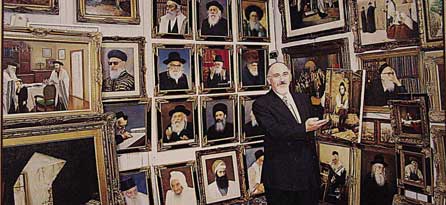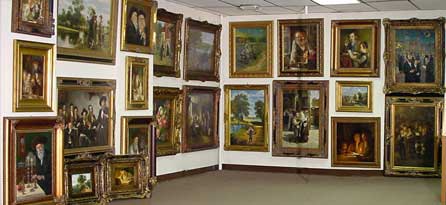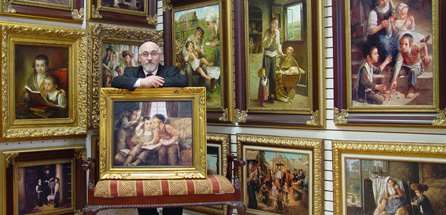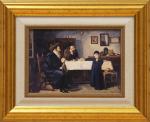|
Samuel Rothbort
There isn't such a thing as a great master or a great poet or a great actor or a great musician. Folk art is great and poor art is better than no art at all. Paint, carve, draw. Pencils are cheap. Wood and stone are plentiful on every step. Colors? Forget about permanency, as the last word is up to nature, and we should have confidence in nature. In a way our " Life is too short ." We have to go back to the Bible. "Death will be abolished forever," and in a broader sense, it is abolished already. Let's throw off the fear and do our art.
Samuel Rothbort ( 1882 - 1971 )
Samuel Rothbort was born in Wolkovisk, White Russia. He was born to a family where the father was a scholar and the mother was a breadwinner operating a flour and grain facility. During his youth he worked as a cantor and traveled to various towns and villages, gaining many impressions of life in that era. Poverty as well as the political unrest of the times led to his immigration to America in 1904.
Upon his arrival in America, Samuel Rothbort worked as a laborer and muralist eventually giving that up to become a watchman of newly built homes. While on duty he began molding figures in clay and upon the advice and encouragement of his employer and colleagues he began to take his artistic talents more seriously and pursued this endeavor.
Samuel Rothbort was self taught, painting every subject in his own impressionistic style. His artistic range was broad and he never stopped creating. He was fascinated with nature and his works are filled with his delightful perceptions of his surroundings. Rothbort worked in oil, watercolor, and pen & ink. In the years of the depression there was little money, Rothbort could not afford paint or canvas. It was there that he began carving wood and stone using found materials like driftwood, rails, and old fence posts. At that time the press called it " Fencepost art ".
Samuel Rothbort was a member of several professional associations of artists, including The Brooklyn Society of Artists, The Society of Independent Artists, and The Salons of America. In 1919, Rothbort was represented in a group show presented by The Brooklyn Society of Artists. It was here that he met critic, teacher, and publicist, Hamilton Easter Field ( 1873 - 1922 ). Field was a leading influence on the development of modernism in the United States, although he remained conservative in his own creative expression. He operated a school and gallery in his home in the Columbia Heights section of Brooklyn and a summer school that he established at Perkins Cove in Ogunquit, Maine. Field characterized Rothbort as exceptionally talented and would serve as Rothbort's patron until his premature death in 1922. In 1952, Rothbort wrote a book on his sculpture, entitled " Out of Wood & Stone " , which he dedicated to Hamilton Easter Field.
During the 1920's and early 1930's , Samuel Rothbort was regularly represented in exhibitions organized by The Brooklyn Museum of Art. Through the 1930's , Rothbort exhibited his watercolors and sculptures at Grant Studios in Brooklyn. In 1940, he began a 28 year relationship with the Barzansky Gallery on Madison Avenue in New York City exhibiting oils, watercolors, and sculpture in individual and group shows.
A significant expression for Samuel Rothbort's career occurred in the late 1930's through the 1940's when he began painting " memory paintings " or recreation of his boyhood experiences of life in the ghettos and surrounding areas of the woodlands and marshes of Polesia - White Russia. A prized winning documentary, " Memories of The Shtetl " was produced by Harriet Semegram ( previously titled " The Ghetto Pillow " ) and shown at the Eidenburgh Film Festival. It utilized 215 of Samuel Rothbort's watercolors and became the major visual resource material for Jerome Robbins movie and play, " Fiddler On The Roof ". Another award winning documentary, " The Lost Wooden Synagogues of Eastern Europe " which was produced by Albert Barry and Florida Atlantic University, used many of Rothbort's paintings in the film to show life in pre-war Eastern Europe. The paintings helped show the viewers what the synagogues looked like in color. The film was shown at the U.S. Holocaust Museum in Washington, D.C. and on Public Television.
Samuel Rothbort died in 1971, leaving behind an impressive collection of paintings and sculpture. His subjects contain flowers, fields, landscapes and other scenes plus over a hundred self-portraits. His work is in many private and public collections, which include the Smithsonian American Art Museum in Washington, D.C.
Artworks:
Click on the thumbnails to see details
Ask us a queston about Samuel Rothbort
|









